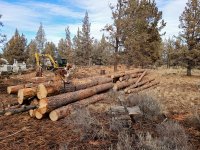You said pine? For firewood? Umm, this is generally not a good idea unless you have some kinda wood burning system I don't know about. Not telling you what to do or how, but I've cut, split, hauled, stacked and fed my share of firewood when I was a kid to a very hungry brick fireplace without a damper that ate 10 inch diameter 32 inch long unseasoned red oak logs in about 3 hours, and we NEVER put any pine in it other than some seasoned knots or splinters (kindling) for starting the fire. In fact, I did all the wood cutting for our house and my step-grandparents, including their fireplace and wood-burning stove. Never even considered pine because of the hazards from the resins. If you can get it dry enough to burn, it burns out like paper. You have more than a slight advantage in the desert for drying, but I can only imagine how much turpentine and resin will be in it because of the slow growth. Here, a pine is big enough for pulp wood in 5 years, lumber in 10. Very thick growth rings.
Burning pine usually creates a lot of soot, creosote, and turpentine, which gets very hazardous very quickly. If you've never seen or heard a chimney get a soot fire, well, let's just say there are some things best not experienced. Mine sorta sounded like a Saturn V rocket turned upside down, and looked like it too. Every neighbor that could see my house called the fire department when they heard it and then saw it. I didn't get to see what it looked like outside, because I was too busy trying to get it shut down. I managed to get it under control (closed the damper nearly off) before they got here, but you could smell the hot metal in that chimney. Apparently, the previous owners used to burn a lot of the pine from the back yard in it, and didn't bother to have the chimney cleaned. Didn't need cleaning after that night. I very nearly lost my house, and would have if the damper hadn't choked the fire back. Should have made sure that was an inspection item before I bought the place.
'Twould be smarter to find a buddy with a sawmill and mill that stuff in to rough lumber, dimensioned so it can be finished if it's knot-free if there's a planer mill in your area. Especially if they're straight. Talk about some good free shed materials. Kinda wish I was near ya. I need a new shed. Depending on how many you have, and how much spare time you have, it might be time to invest in a mill. A decent one can be had for about $5K. Have you seen the price of lumber lately? Especially 12 foot long lumber! If you're in the High Desert, you're probably talking air-dried rough-cut lumber in two weeks, especially if you dry it in summer. Just keep the sun off it, or it'll crawl off by itself. That's some big bucks, and the mill would nearly pay for itself with the first cutting. It looks like a lotta work, though.

